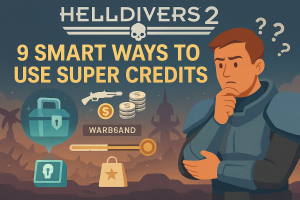The development of the game and its duration depends on the game itself, the budget and the number of people. On average, one game can take from 1 to 2 years, and an AAA project from 2 to 3 years. However, this is approximate. After all, someone created Resident Evil 3 Remake in 3 years, and someone from the indie environment spent almost 11 years of work on the conditional Disco Elysium. Game development life cycles are also different, but you can bring them down to 10. Let’s talk about them in a nutshell.
1 the conundrum
Just as once the monkey took a stick in his hand and thought of fighting off predators, so the game development begins with the fact that someone comes up with an idea about a plot, character or mechanics that can become the basis for a future game.
And in fact, this is a difficult stage, since it includes designing what the game will be, its genre, visual style, setting, heroes, who is the target audience of the project and what platform the game will be on. Thinking over all these details, a concept is formed, from which all other stages of game development will follow. It also includes the technical part: on which engine it will be and whether it is necessary to create a new one, what budget may be required, what kind of monetization is in the game. And much more. In addition, the entire concept must be verified by the publisher, if any.
2. Document
When the concept is confirmed, many studios create a design document, where all ideas are introduced, from the design of locations, atmosphere, and ending with characters. It is constantly changing throughout development right up to the very moment when the game is not released.
3. Assembling the team
Usually, everything described above is planned by a group of people, not by entire studios. A team is being assembled, which is needed to implement all the crazy plans and ideas written in the design doc. And this is where the fun begins. Also, a chief game designer or simply a project manager is appointed, dictating what and how to do.
4. Pre-production
The formed team begins to try to figure out how to implement the plans. A brainstorm begins for absolutely everyone, from game designers, artists, screenwriters and programmers to engineers, publishers, project managers and other departments. They put together the puzzle piece by piece to see the whole picture.
The writers write the story, meet with the engineers, who explain to them that the current technology of the studio does not allow creating a game with hundreds of heroes. Designers and artists come to a style agreement and draw concept art. Developers and engineers plan to implement mechanics in terms of scenario, physics and other rules of the world.
5. Budget
If this has not happened yet, then somewhere in this period, the developer should definitely kneel in front of the publisher and humbly stretch out his hand, voicing a round number. If this is an AAA project, the amounts can be in the millions, and they only increase every year. And when the publisher agrees to it, he automatically multiplies the amount by two, since the second part of the budget goes to marketing, which will gobble up as much dough as the development itself.
6. Creating a game
The most difficult stage begins – production. During this period, the entire game is collected. Levels, design, characters, sound are created, programming, voice acting is in progress. In simple words – blood, sweat pixels and tons of lines of code.
At this time, the publisher plans and starts a marketing campaign. Moreover, I would like to highlight the creation of the first level, because it is it that is developed the longest and more thoroughly.
7 testing the game
During the testing phase, poor and tortured QA employees check how the game works, find bugs, problems. Often they are the ones responsible for all the dirty work of finding problems. By the way, read in detail about how to become a video game tester in our separate materials. After lengthy tests, the game should be ready for an alpha or beta test. Regardless of whether it is open or closed. Here, some developers can cheat and release the game into Early Access to find new tools to create it.
8. Preparation for launch
As a rule, at this stage of the creation of the game, it is shown to people or the press. It can be a story or gameplay trailers, or even the first level, and viewers and hacks start scribbling their opinions on the Internet. At this point, developers may have doubts about what they are doing. And is it all right.
9. Launch
This is a favorite part of Kotaku’s Jason Schreier in video game development, as it provides him with work for years to come. Everything that can be completed is being completed and everything possible is being corrected.
10. Post-release support
The final phase of game development is to maintain and release at least a day one patch. After that, other patches will also be sawed. If this is a game service, new content is created for it, which will be constantly updated. If it’s a story-driven game, you can release DLC for it.
And you can order a quality product from https://kevurugames.com/blog/why-are-aaa-games-so-expensive-everything-you-need-to-know-about-the-budget/.





